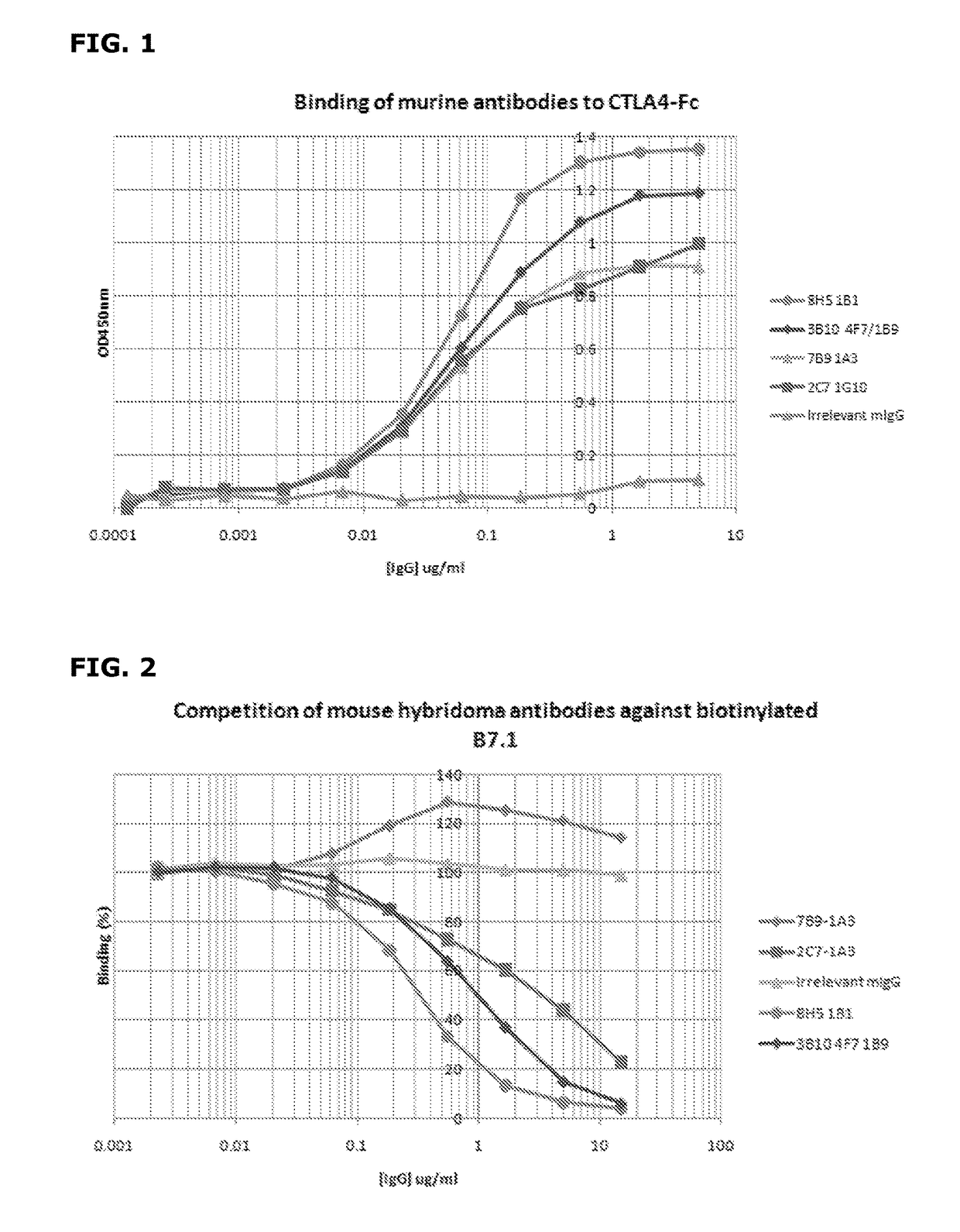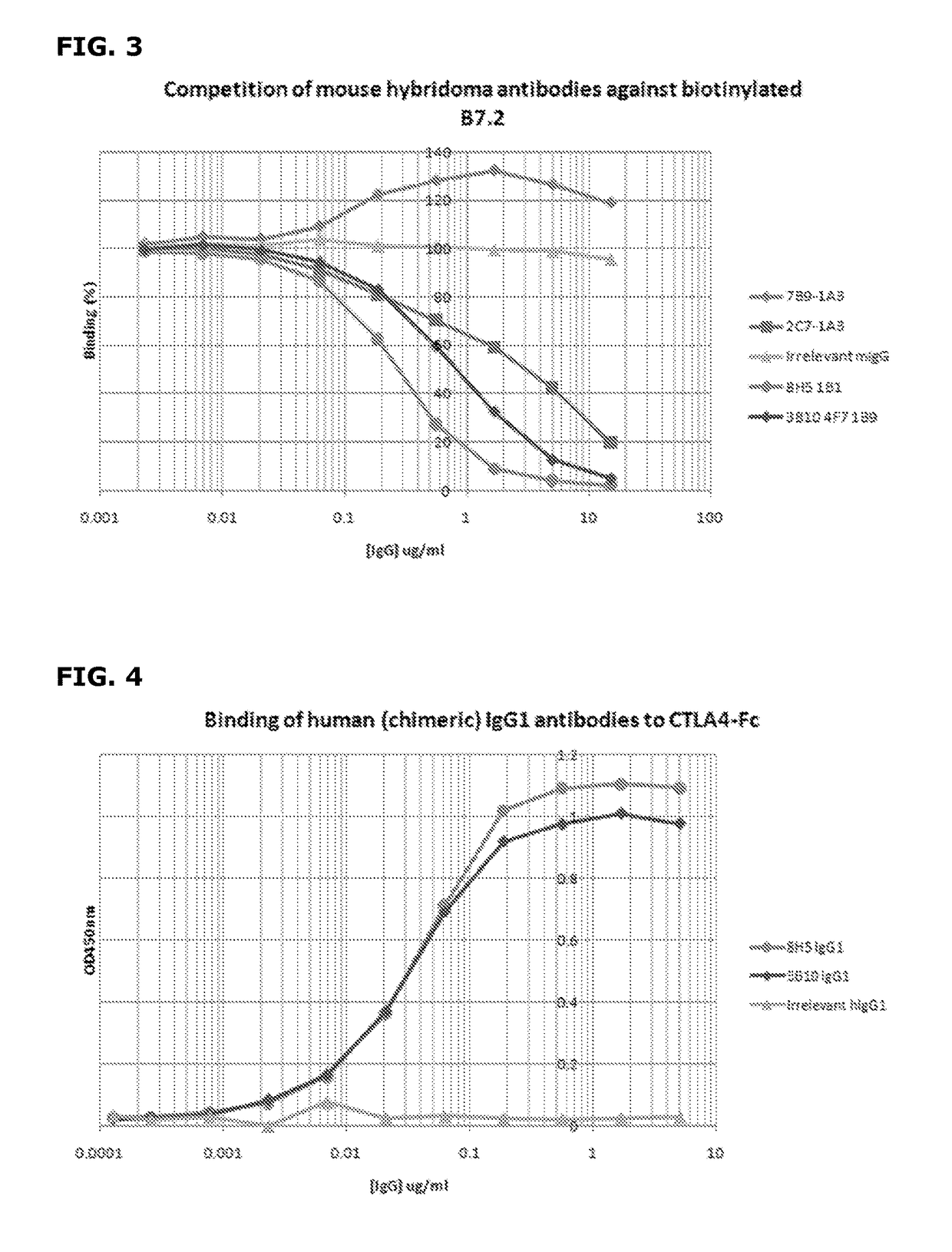Humanised anti CTLA-4 antibodies
a technology of humanized anti-ctla4 and anti-ctla4, which is applied in the field of humanised anti-ctla4 antibodies, can solve the problems of lack of therapeutic effect and adverse effects, and achieve the effects of augmenting or prolong and inducing the immune response to an antigen
- Summary
- Abstract
- Description
- Claims
- Application Information
AI Technical Summary
Benefits of technology
Problems solved by technology
Method used
Image
Examples
example 1
Generation of Mouse Monoclonal Antibodies
[0049]Recombinant CTLA4-fusion protein comprising the extracellular domain of human CTLA4 fused to the human IgG1 constant domain was purchased from R&D Systems (Oxford, UK). Extracellular CTLA4 fragment was prepared by proteolytic cleavage of the CTLA4-Fc fusion protein with Factor Xa (Qiagen, Crawley, UK) followed by subsequent removal of the protease using Factor Xa removal resin (Qiagen) and of the cleaved Fc fragment using Protein A-agarose to leave the CTLA4 extracellular domain only.
[0050]Female Balb / c mice were immunised subcutaneously with 200 ul of a 1:1 emulsion of Freunds Complete Adjuvant (Sigma-Aldrich, Dorset, UK) containing 20 ug of CTLA4-Fc fusion protein. Immunised mice were subsequently boosted approximately every 3 weeks with up to three intraperitoneal injections of a 1:1 emulsion of Freunds Incomplete Adjuvant (Sigma-Aldrich) containing 20 ug of CTLA4-Fc. 3 days prior to myeloma fusion, the two mice showing the highest a...
example 2
Variable Region Gene Sequencing
[0058]Subclones 3B10-4F7, 3B10-6E3, 8H5-1A1 and 8H5-1B1 producing the lead monoclonal antibodies 8H5 and 3B10 were subjected to variable region (V-region) sequence analysis. Total RNA was extracted from 3 to 10×106 hybridoma cells using the RNAqueous-4PCR Kit (Ambion, Warrington, UK) and used to synthesis cDNA. Murine immunoglobulin heavy and kappa light chain V-region fragments were amplified by PCR using degenerate mouse leader sequence primers (Sigma) and unique constant domain primers (Sigma) as shown in FIG. 20. The resulting PCR fragments were subcloned into the pGEM-T Easy I vector system (Promega, Southampton, UK) and inserts were sequenced using the vector-specific primer, M13Forward (Sigma). All DNA sequencing was performed by Geneservice Ltd, Cambridge, UK. Unique V-region nucleotide sequences were obtained for 3B10 (SEQ ID Nos 1 and 2) and 8H5 (SEQ ID Nos 5 and 6). Sequences of 3B10 and 8H5 hypervariable regions (CDRs) were determined as fo...
example 3
Generation of Chimeric Antibodies
[0060]The heavy and light chain variable domain sequences of the lead 3B10 and 8H5 monoclonal antibodies were PCR amplified and subcloned into pANT antibody expression vectors (FIGS. 8A-8B) with heavy and light chain V-regions cloned into pANT17 and pANT13 respectively. Heavy chain V-region genes were cloned into pANT17 via MluI and HindIII sites in frame with either the human γ1 heavy chain gene (G1m3 (G1m(f)) allotype) or the human γ4 heavy chain gene, and light chain V-region genes were cloned into pANT13 via BssHII and BamHI sites in frame with the human kappa light chain constant region gene (Km3 allotype). Transcription of both heavy and light chain genes was under the control of the CMV I / E promoter (U.S. Pat. No. 5,168,062 and U.S. Pat. No. 5,385,839, University of Iowa) and the pANT17 plasmid contained a mutant dhfr minigene (Simonsen & Levinson 1983, PNAS 80:2495-2499) under the control of a SV40 promoter and polyA sequence for selection in...
PUM
| Property | Measurement | Unit |
|---|---|---|
| equilibrium dissociation constant | aaaaa | aaaaa |
| Tm | aaaaa | aaaaa |
| volumes | aaaaa | aaaaa |
Abstract
Description
Claims
Application Information
 Login to View More
Login to View More - R&D
- Intellectual Property
- Life Sciences
- Materials
- Tech Scout
- Unparalleled Data Quality
- Higher Quality Content
- 60% Fewer Hallucinations
Browse by: Latest US Patents, China's latest patents, Technical Efficacy Thesaurus, Application Domain, Technology Topic, Popular Technical Reports.
© 2025 PatSnap. All rights reserved.Legal|Privacy policy|Modern Slavery Act Transparency Statement|Sitemap|About US| Contact US: help@patsnap.com



